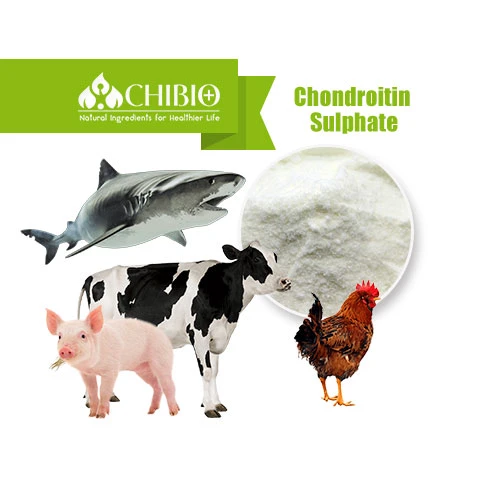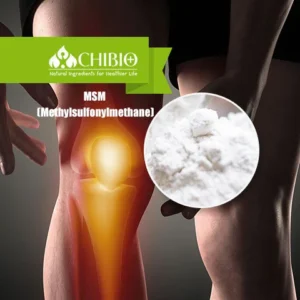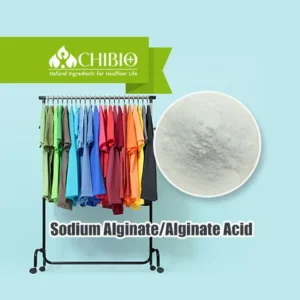Chondroitin Sulphate
Chondroitin Sulphate
Additional information
Product Details

What is Chondroitin Sulphate?
Chondroitin sulfate (CS) is a class of glycosaminoglycans that are covalently linked to form proteoglycans on proteins. Chondroitin sulfate is widely distributed in the extracellular matrix and cell surface of animal tissues. The sugar chain is composed of alternating glucuronic acid and N-acetylgalactosamine (also known as N-acetylgalactosamine) disaccharide units through a sugar-like substance. The linker region is attached to the serine residue of the core protein.
Chondroitin sulfate exists in all organisms from nematodes to humans except plants, and plays many important physiological functions. Although the main chain structure of the polysaccharide is not complicated, it exhibits a high degree of heterogeneity in terms of the degree of sulfation, the distribution of the sulfate group and the two isomeric uronic acid rechains. The fine structure of chondroitin sulfate determines the specificity of the function and interaction with a variety of protein molecules.
Choncroitin Sulphate is an acid mucopolysaccharide prepared by extracting from animal tissues, which is white or off-white powder; odorless; hygroscopic. The aqueous solution of this product is viscous and does not condense when heated. This product is soluble in water, insoluble in organic solvents such as ethanol, acetone, and ether. Its salts are stable to heat and are not destroyed by heat up to 80 °C. An aqueous solution of chondroitin sulfate, which is unstable when subjected to higher temperatures or acids, is mainly deacetylated or degraded into a monosaccharide or a polysaccharide having a relatively small molecular weight.
How Chondroitin Sulfate Works?
Chondroitin is a major component of the human extracellular matrix (ECM), which is a component present within all tissues and organs that provides physical “scaffolding” for tissues. The ECM is composed of water, proteins and polysaccharides.
Chondroitin helps link together sugar and protein molecules and serves an important role in maintaining the structural integrity of tissue. Its primary benefit and mechanism of action is stimulating regeneration of cartilage, which is the connective tissue that cushions the ends of bones within joints.
Within chondroitin are tightly packed sulfate groups that form a barrier that can withstand compression, shock and even electrostatic charges that damage tissue. Chondroitin is technically a form of a complex carbohydrate, giving it shock and water-absorbing capabilities and making it crucial for allowing joint/bone movement without friction. This is why the loss of chondroitin from cartilage is a major cause of osteoarthritis that degenerates joints.
It’s also important for forming tissue elsewhere in the body, including the skin, GI tract and the brain. In regard to the the brain’s extracellular matrix, it helps stabilize normal brain synapses and protects the brain from injury. Following trauma to the brain, levels of chondroitin are increased rapidly to help regenerate new tissue in order to replace damaged nerve endings.
Specification of Chondroitin Sulfate
|
ANALYSIS |
SPECIFICATION |
|
Product Name |
Chondroitin Sulphate/ Sulfate |
|
Appearance |
White to Off-white Free Flowing Powder |
|
Clarity and Color of Solution |
0.35 Max at 420nm |
|
Specific Rotation |
-20.0°~-30.0° |
|
Chondroitin Sulfate Assay (CPC) |
85% 90% 95% 98% ( O.D.B) |
|
Loss on Drying |
≤10% |
|
Residue on Ignition |
20%-30% |
|
PH |
5.5-7.5 |
|
Particle size |
100%through 80mesh |
|
Protein Heavy Metals (Pb) Sulfate Chloride |
≤6% ≤20PPM ≤0.24% ≤0.50% |
|
Microbiology |
|
|
Total Plate Count |
<1000cfu/g |
|
Yeast & Mold |
<100cfu/g |
|
E.Coli |
Negative |
|
Salmonella Clostridium |
Negative Negative |
Benefits & Applications of Chondroitin Sulfate
Chondroitin is one of the most sought after joint-supporting supplements available on the market today, due to how it helps rebuild cartilage naturally and boosts recovery of tissue after injury or exercise.
As an important structural component of cartilage and one of the key substances that allows joints to withstand pressure, chondroitin is taken by many people with joint pain, osteoarthritis, and other signs of “wear and tear” due to aging. It’s commonly available in formulas containing similar and complimentary supplements, especially glucosamine and MSM.
Aside from offering relief to those with arthritis, chondroitin (and glucosamine) may help people dealing with conditions like chronic knee pain or sacroiliac pain (SI joint pain) that causes upper leg and lower back pain discomfort.
TOP 3 CHONDROITIN BENEFITS
1. Helps Treat Osteoarthritis Joint Pain

Estimates show that over 27 million adults in the U.S. live with osteoarthritis, which is the most common type of arthritis and degenerative joint diseasethat’s characterized by the breakdown of cartilage and increased joint pain. Chondroitin sulfate is commonly used to treat pains associated with osteoarthritis, especially forms that affect very susceptible body parts like the knees and hands.
Overall, studies have shown that use of chondroitin tends to cause modest improvements in joint pain over the course of several months, although some people experience even more benefits and more quickly — especially when combining several supplements together and making other changes like eating an arthritis diet to treat symptoms.
According to the Arthritis Foundation, on average study participants usually experience about a 10 percent improvement in painful symptoms when using chondroitin compared to placebo. The best results are usually achieved after using a product containing it for three months or more.
Recently, the University of Utah’s School of Medicine conducted the largest-ever clinical study investigating the effects of chondroitin and glucosamine, called “The Glucosamine/Chondroitin Arthritis Intervention Trial (GAIT).” According to reports released by the National Center for Complementary and Integrative Health, GAIT is the first large-scale, multicenter clinical trial in the U.S. to test the effects of the dietary supplements glucosamine hydrochloride (glucosamine) and sodium chondroitin sulfate (chondroitin sulfate) for the treatment of knee osteoarthritis.
- The GAIT study compared the effects of glucosamine and chondroitin sulfate (used separately and also in combination) to effects of a placebo and also a prescription drug.
- 16 rheumatology research centers across the U.S. and over 1,500 patients participated in the study, which lasted six months.
- Patients received one of five treatments over the course of six months, including the use of glucosamine and chondroitin, celecoxib (a popular prescription drug used for managing osteoarthritis pain) or a placebo. A positive response to any treatment was defined as a 20 percent or greater reduction in pain after six months compared to the start of the study.
- Results of the GAIT study showed that for participants with moderate to severe pain, glucosamine combined with chondroitin sulfate provided statistically significant pain relief compared with the placebo — about 79 percent had a 20 percent or greater reduction in pain versus about 54 percent for placebo group.
- Chondroitin and glucosamine actually worked for more people than the prescription did — 70 percent of participants in the celecoxib group experienced pain relief compared to placebo.
- However, for participants in the mild pain subset, glucosamine and chondroitin sulfate seemed to do less to reduce their pain. These participants on average didn’t experience statistically significant pain relief like those with more severe pain did.
Results from another randomized, double-blind, placebo-controlled clinical trial that appeared in Arthritis and Rheumatism tested the effects of chondroitin taken by 162 symptomatic patients with osteoarthritis of the hand.
The results showed that patients who experienced chronic hand pain and took 800 milligrams of chondroitin sulfate (CS) daily experienced on average modest pain relief, reduced morning stiffness and improvements in overall functionality within three to six months of regular use.
Researchers also found that the majority of patients experienced no adverse side effects due to chondroitin, which often can’t be said of other painkilling medications that can cause adverse effects like stomach ulcers, dependence, digestive issues, blood pressure problems and more. The researchers’ conclusion was that “CS improves hand pain and function in patients with symptomatic OA of the hand and shows a good safety profile.”
2. Helps with Injury and Exercise Recovery

Even for people without osteoarthritis, there’s evidence suggesting that chondroitin used with glucosamine helps preserve valuable cartilage, decreases pain, increases physical function and enhances self-care activities.
It can reduce joint stress following exercise or injury by helping the body synthesize new cartilage, keeping joints flexible and controlling the body’s natural inflammatory responses.
3. Improves Wound Healing and Skin Health

Chondroitin and glucosamine are also used together to help heal wounds, skin-related defects, inflammation of the skin and even in veterinary medicine. Chondroitin can help the body produce collagen, which is essential for skin health, healing and fighting the effects of aging on the skin.
Treatments made using chondroitin and glucosamine are often used for wound dressing even for severe wounds, plus applied over scrapes, burns and lesions to keep wounds moist and promote faster recovery. Some studies have even found that in patients with burns requiring skin grafting, the use of chondroitin in treatment gels can speed up healing time and help control inflammation significantly.
Another substance/supplement that chondroitin may be combined with to improve skin health is hyaluronic acid. Hyaluronic acid (HA) is found in skin, eye sockets, all bones, connective tissue, joints, tendons and cartilage structures throughout the body — especially a type called hyaline cartilage, which covers the ends of bones and provides cushioning. It’s a lubricating, clear substance that’s produced by the body naturally to increase moisture and provide elasticity and flexibility.
The primary way in which HA helps improve appearance of “chronoaged skin” (skin aged due to sun exposure) is by reducing water loss and therefore dryness, dandruff, drooping eyes or lips, and sagginess/loss of volume.
You can find hyaluronic acid lotions, creams, serums and supplements sold in health food stores, plus it’s also a naturally occurring ingredient in bone broth, Because it helps form synovial fluid and can buffer bones while providing resistance to wear and tear, hyaluronic acid is also useful for lowering pains and tenderness associated with degenerative joint diseases.









